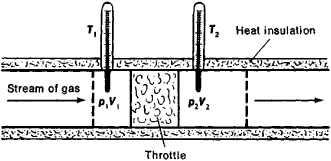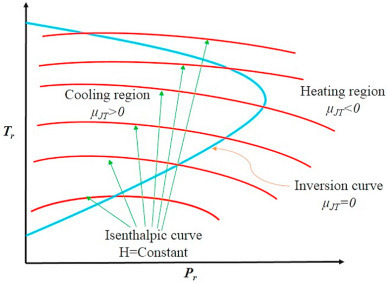Joule Thomson Effect
In a Joule-Thomson (or throttling) process, a gas flow through a pipe having constriction (a valve or porus plug). There is no heat exchange between the gas and the pipe. The enthalpy ($H=U+pV$) of the gas remains constant. It is an isenthelpy process. The temperature of the real gases usually decreases (cooling) but that of an ideal gas remains constant.

In this process, a gas initially confined in fixed volume escapes freely without exchanging heat with its environment,
- gas in the first compartment at $(T_1,V_1,p_1)$
- expands into second compartment of volume $V_2$ under constant pressure $p_2$ ($p_2 < p_1$)
- two compartments are thermally isolated; connected by porous plug to maintain pressure difference
- adiabatic (but not quasi-static) expansion.
The first law of thermodynamics gives \begin{align} \Delta H &= H_2 - H_1 \\ &= U_2 + p_2 V_2 - U_1 - p_1 V_1 \\ &= \Delta U + p_2 V_2 - p_1 V_1 \\ &=0 \end{align} The enthalpy is constant for this expansion.
Joule Thomson coefficient of a gas is defined as \begin{align} \mu=\left( \frac{ \partial T}{ \partial p }\right)_H. \end{align} The temperature of the gas remains constant if $\mu = 0$ (e.g., an ideal gas). The temperature decreases if $\mu > 0$ (a real gas) and the temperature increases if $\mu < 0$.

Every real gas has an inversion temperature such that below the inversion temperature, $\mu=\left( \frac{ \partial T}{ \partial p} \right)_H > 0$, and so $dT < 0$ as $\mathrm{d}p < 0$ and the gas cools. Above the inversion temperature, $\mu= \left( \frac{ \partial T}{ \partial p} \right)_H < 0$, and so $dT > 0$ as $\mathrm{d}p < 0$ and the gas warms.
An inversion temperature exist because when the molecules are close enough, there are intermolecular forces that'll make them attract each other so the interaction energy is negative.
Experimental demo
Air under pressure expands suddenly and lowers the temperature.
Procedure
Bring your palm in front of your face. Blow air from your mouth on the palm, keeping your mouth wide open. Your palm will feel warm. Now, bring your lips close to each other leaving a small gap between them. Blow air again. This time palm will feel cold.
Discussion
When the mouth is wide open, the warm air from your body touches your palm and it feels warm. But in the second case the air under pressure inside your mouth suddenly expands. While expanding, the warm air molecules have to do work against inter-molecular forces of attraction between the molecules. For doing work, the air needs energy. It gets energy from the heat of the air. When heat is taken out, the air cools and when this cold air strike the palm, you feel cooler. This cooling by expansion of a gas is known as Joule Thomson effect. Joule-Thomson effect provides a practical method of liquefying gases like nitrogen, oxygen etc.
Related
Subscribe to our channel
